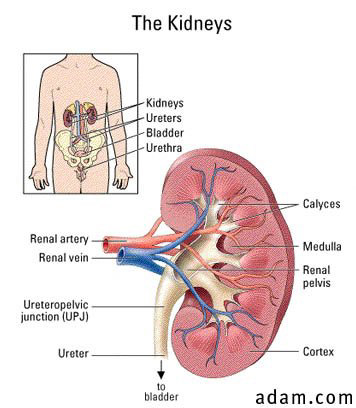 Adams IV for News The specialist: Dr. Michael A. Palese on kidney cancer
Adams IV for News The specialist: Dr. Michael A. Palese on kidney cancer
The director of minimally invasive surgery in the Department of Urology at the Mount Sinai Medical Center, Dr. Michael A. Palese specializes in robotic, laparoscopic and endoscopic surgery for kidney cancer. he has performed more than 2,000 minimally invasive kidney procedures.Who’s at riskKidney cancer was diagnosed in over 58,000 Americans in 2010.”Typically it affects more men than women, and last year there were over 13,000 deaths from kidney cancer,” says Palese. “About 1 in 70 Americans will potentially develop kidney cancer,” he says. The average age of diagnosis is 64, but kidney cancer can affect all age groups.While there is a genetic component to kidney cancer, the biggest risk factor is smoking. “Obesity, hypertension and long-term dialysis are additional risk factors, as are occupational and chemical exposure to things like asbestos, cadmium, certain organic solvents and certain herbicides,” says Palese.Signs and symptomsKidney cancer exhibits a trademark cluster of symptoms. “The classic triad for kidney cancer is blood in the urine, pain and a flank mass, which people might feel as a bulge in their side,” says Dr. Palese.”Fortunately, we are detecting kidney cancer at a much earlier stage today,” he says. Most cases are being diagnosed by ultrasound, MRI or CAT scan. Often these were done for another diagnostic reason.There is no blood test for kidney cancer or recommended routine screening, like colonoscopy for colon cancer.”Blood in the urine is the main marker,” says Palese. “Secondary signs include weight loss, fever, fatigue, night sweats and other changes in laboratory values, such as increased liver function tests and increases in the red blood cell count.”Traditional treatmentEarly diagnosis is the key to fighting kidney cancer. “If we catch the cancer when it is still localized, the five-year survival rate is over 90%,” says Palese. “If it has spread to lymph nodes, it is about 60%.” if the cancer has metastasized, the survival rate drops to 10%.Kidney cancer is one of the few cancers that does not respond to chemotherapy or radiation, so surgery is the number one option. “We usually don’t biopsy kidney cancer, because there is a high false negative rate,” says Dr. Palese. “So the treatment of choice is to remove the tumor and get a clear margin.” in the past, surgeons would remove the whole kidney, but now the goal is to remove only the tumor through a partial resection, and leave the rest of the healthy kidney behind.Traditionally, kidney surgery has always been done through an open approach, which meant a large incision, longer hospitalization and longer recovery for the patient. Attempts were made to improve this by performing laparoscopic, or “keyhole,” surgery. but laparoscopic partial nephrectomy is a very complicated procedure, and only experienced surgeons could perform it. “With the introduction of robotic surgery,” says Palese, “many tumors which were previously thought to be unresectable as a partial nephrectomy can now be done. Thanks to this new minimally invasive technique, people have less pain and blood loss, and get back on their feet quicker.”Kidney cancer can recur after surgery, so patients must remain on surveillance for the rest of their lives. “It is very important that you follow up with your doctor regularly after kidney cancer surgery,” says Palese.Research breakthroughsRobotic kidney surgery is a new procedure that has become increasingly common since it was first introduced in 2005.”Robotic kidney surgery is for people with localized kidney cancer,” says Dr. Palese. “Our goal is to remove the tumor and leave behind the rest of the healthy kidney, which will increase quality of life and decrease problems associated with loss of a whole kidney.” The technical name for the surgery is robotic partial nephrectomy.in the past five years, even more treatment options for late-stage kidney cancer patients have evolved. “There are five new targeted therapies that affect specific proteins involved in the spread of the kidney cancer,” Dr. Palese. “These can reduce replication and prolong survival rates.” Several more targeted drugs are also on the horizon. “Like robotic surgery, we’re just using these targeted therapies in the last five years, so our statistics are rapidly changing,” says Palese. “A whole new world in kidney cancer treatment has opened up.”Questions for your doctorAs with any surgery, be sure to ask your doctor, “What risks are associated with surgery?” in addition, it’s important to find an experienced surgeon, so ask “How many of these surgeries have you done?” Robotic surgery is still a new technique, and Dr. Palese advises patients to seek out an expert. “It’s a tool, so it’s only as good as the surgeon using it.”What you can doGet informed.The web has sites that provide a great deal of information on kidney cancer. use a reliable source like the American Cancer Society (cancer.org), the American Urological Association (auanet.org), the Kidney Cancer Association (kidneycancer.org) or the National Cancer Institute (cancer.gov).Don’t ignore blood in the urine.Go see a doctor immediately. “Blood in the urine calls for a workup,” says Dr. Michael A. Palese.Surveillance is vital.If you have a family history of kidney cancer and kidney disease, make a plan with your doctor to monitor your health.